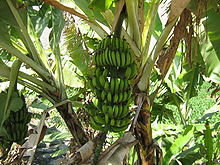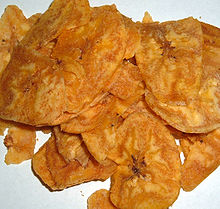- Chifle
-
 Peruvian Plantain.
Peruvian Plantain.
Chifle is a side dish, snack food, or finger food of Peru and Ecuador,[1] consisting of fried slices (chips or crisps) of green or ripe plantain. Chifle is not to be confused with banana chips.[2]
Contents
In Peru
In Peru chifle is typical of the Piura Region.[3] It consists of fried slices or strips of either ripe or green plantains seasoned with salt to taste. In the region of Piura, chifle is traditionally fried in wood-burning stoves with wood of the algorrobo blanco (a species of mesquite tree), which gives chifle a special aroma and taste. Depending on the type of plantain (ripe or green) the flavor can be sweet or savory. Sometimes it is served with cancha serrana (pan-roasted maize) or shredded cecina (pork jerky).
At present, the Asociación de Productores de Chifles Piuranos (APROCHIP, English: Piura Chifle Producers Association) has initiated the process to declare chifle as a producto de bandera nacional (English: flagship product) of Peru.[4][5] APROCHIP of Piura is an agglomeration of 14 local commercial chifle producers.[6]
In Ecuador
The variety of plantain used in Ecuador for some culinary compositions is called "dominico", either in honor of the Orden de Predicadores or because the name was passed from Santo Domingo (the capital of the Dominican Republic) to the coast of Ecuador. Chifle is made with green domingo plantains. Chifle is often served along with mazamorra or as a side dish with caldo (soup), especially beef caldo. Chifle is often served with ceviche (a seafood dish), which is also always served with maize roasted in shortening.
Process
An incision is made in the peel the full length of the plantain, and the peel is removed by hand. The plantains are immediately placed in salt water. Then the plantain is cut into thin slices, either across (round slices, like chips), or lengthwise (strips). The plantain slices are cooked in hot oil until golden and crispy. Then they are seasoned with salt.
A more crispy variety of chifle is prepared and packaged in factories. This includes sweet, savory, and spicy varieties. The commercial production and export of chifle was a product of the fact that South American travelers were interested in the uses of plantains. Early 19th Century travelers on ships entering and leaving the port of Guayaquil were served chifle (instead of bread) with meals, including breakfast, and discovered its use as a snack food.
Etymology
According to Peruvian historians, the term "chifle" most likely comes from the Arabic "chofre", which in Medieval Spain was used to refer to the blade of the sword, lending the name to the snack food of fried plantains sliced into circles with the blade of a sword.[3] Another view is that "chifle" means horn (or antler) and the term was used because of the resemblance between the two.[6] A third view suggests that the term originates from the whistling sound made while eating the snack.[3]
The word "chifle" is of unknown origin and does not appear in the dictionary of the Spanish language.[7] In the rural social environment of the Ecuadorian coast, principly in the provinces of "Montubio" cultural origin, "chiflar" was a vulgar and coloquial term that means to "whistle" with the mouth in a notably sharp sound by pinching the bottom lip and pushing air out from the lungs, resulting in a strong sound (sometimes pleasant or unpleasant) to catch the listener's attention. In the Montubia ethnic culture of the coast of Ecuador, this sound was popularly used to call family or close kinsmen from long distances.
Similar preparations in other countries
 Platanutres from Puerto Rico.
Platanutres from Puerto Rico.
Every tropical country where the plantain is in high consumption has its local version of this snack. It is known as chipilo in Bolivia; plataninas in Guatemala; pazhampori in South India; mariquitas (English: lady bugs) in Cuba;[8] in Puerto Rico platanutres.[9]
See also
- Banana chips
- Cuisine of Peru
- Plantain
- Tostones
References
- ^ Exportación de chifles deja $2 millones al año (Spanish)
- ^ Chifle is made from plantains, not bananas (a different kind of plantain). While all bananas are plantains, not all plantains are bananas.
- ^ a b c Zapata Acha, Sergio (November 2006). Diccionario de gastronomía peruana tradicional (1 ed.). Lima, Peru: Universidad San Martín de Porres. ISBN 9972-54-155-X. (Spanish)
- ^ Peru's flagship products are products whose origin, cultural expression, or transformation occurred in Peruvian territory with features that represent the image of Peru outside the country. The Comisión Nacional de Productos Bandera (COPROB, English: National Flag Products Commission) is the Peruvian agency that aims to achieve an export base and strengthen its presence in international markets.
- ^ Agencia Andina de Noticias (2008-11-31). "Piura busca declaratoria de chifle como producto de bandera nacional" (in Spanish) (Web). http://www.andina.com.pe/Espanol/Noticia.aspx?id=E7cTbKxHSQc=. Retrieved 19 April 2009.
- ^ a b Diario El Comercio (November 25). "¿Por qué los chifles piuranos no pueden ser exportados?" (in Spanish) (Web). El Comercio (Perú). http://www.elcomercio.com.pe/ediciononline/HTML/2008-11-25/por-que-chifles-piuranos-no-pueden-exportados.html. Retrieved April 19, 2009.
- ^ Julio Pazos B., Ecuador Terra Incognita - Chifles (Spanish)
- ^ Cocina Cubana: Mariquitas de plátanos verde (Spanish)
- ^ Mario Pagán, Utilisma: Platanutres (Spanish)
External links
Deep-fried foods Banana chips · Chifle · Chicken fried bacon · Coca Cola · Egg roll · Fish · Finger steaks · French fries · Fried chicken · Fried pickle · Mars bar · Mozzarella sticks · Onion ring · Peanuts · Pizza · Potato chips · Tater tot · Tempura · Tortilla chip · Twinkie
 Recipes on WikiBooks ·
Recipes on WikiBooks ·  Category:Deep fried foods ·
Category:Deep fried foods ·  Portal:FoodCategories:
Portal:FoodCategories:
Wikimedia Foundation. 2010.


